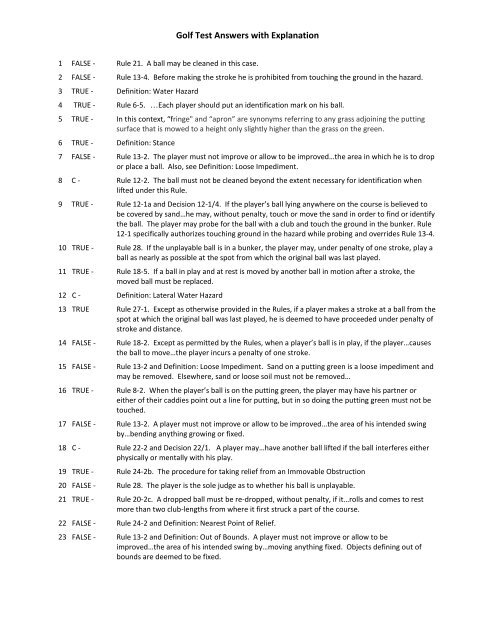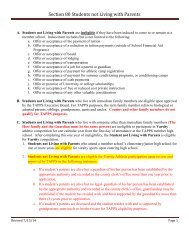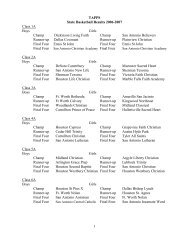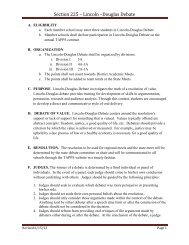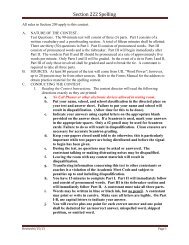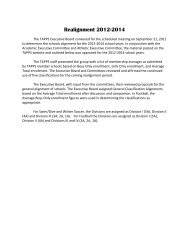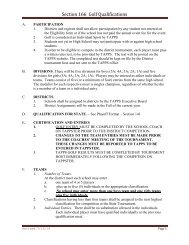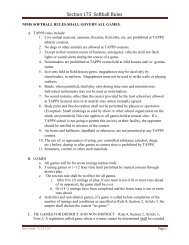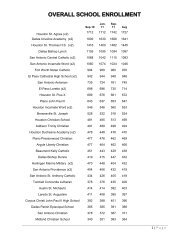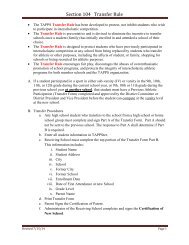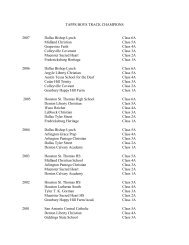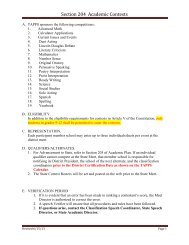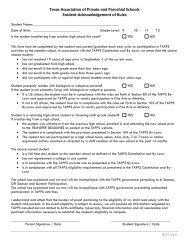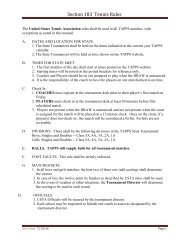Golf Test Answers with Explanation - tapps
Golf Test Answers with Explanation - tapps
Golf Test Answers with Explanation - tapps
Create successful ePaper yourself
Turn your PDF publications into a flip-book with our unique Google optimized e-Paper software.
<strong>Golf</strong> <strong>Test</strong> <strong>Answers</strong> <strong>with</strong> <strong>Explanation</strong><br />
1 FALSE - Rule 21. A ball may be cleaned in this case.<br />
2 FALSE - Rule 13-4. Before making the stroke he is prohibited from touching the ground in the hazard.<br />
3 TRUE - Definition: Water Hazard<br />
4 TRUE - Rule 6-5. …Each player should put an identification mark on his ball.<br />
5 TRUE - In this context, “fringe" and “apron” are synonyms referring to any grass adjoining the putting<br />
surface that is mowed to a height only slightly higher than the grass on the green.<br />
6 TRUE - Definition: Stance<br />
7 FALSE - Rule 13-2. The player must not improve or allow to be improved…the area in which he is to drop<br />
or place a ball. Also, see Definition: Loose Impediment.<br />
8 C - Rule 12-2. The ball must not be cleaned beyond the extent necessary for identification when<br />
lifted under this Rule.<br />
9 TRUE - Rule 12-1a and Decision 12-1/4. If the player’s ball lying anywhere on the course is believed to<br />
be covered by sand…he may, <strong>with</strong>out penalty, touch or move the sand in order to find or identify<br />
the ball. The player may probe for the ball <strong>with</strong> a club and touch the ground in the bunker. Rule<br />
12-1 specifically authorizes touching ground in the hazard while probing and overrides Rule 13-4.<br />
10 TRUE - Rule 28. If the unplayable ball is in a bunker, the player may, under penalty of one stroke, play a<br />
ball as nearly as possible at the spot from which the original ball was last played.<br />
11 TRUE - Rule 18-5. If a ball in play and at rest is moved by another ball in motion after a stroke, the<br />
moved ball must be replaced.<br />
12 C - Definition: Lateral Water Hazard<br />
13 TRUE Rule 27-1. Except as otherwise provided in the Rules, if a player makes a stroke at a ball from the<br />
spot at which the original ball was last played, he is deemed to have proceeded under penalty of<br />
stroke and distance.<br />
14 FALSE - Rule 18-2. Except as permitted by the Rules, when a player’s ball is in play, if the player…causes<br />
the ball to move…the player incurs a penalty of one stroke.<br />
15 FALSE - Rule 13-2 and Definition: Loose Impediment. Sand on a putting green is a loose impediment and<br />
may be removed. Elsewhere, sand or loose soil must not be removed…<br />
16 TRUE - Rule 8-2. When the player’s ball is on the putting green, the player may have his partner or<br />
either of their caddies point out a line for putting, but in so doing the putting green must not be<br />
touched.<br />
17 FALSE - Rule 13-2. A player must not improve or allow to be improved…the area of his intended swing<br />
by…bending anything growing or fixed.<br />
18 C - Rule 22-2 and Decision 22/1. A player may…have another ball lifted if the ball interferes either<br />
physically or mentally <strong>with</strong> his play.<br />
19 TRUE - Rule 24-2b. The procedure for taking relief from an Immovable Obstruction<br />
20 FALSE - Rule 28. The player is the sole judge as to whether his ball is unplayable.<br />
21 TRUE - Rule 20-2c. A dropped ball must be re-dropped, <strong>with</strong>out penalty, if it…rolls and comes to rest<br />
more than two club-lengths from where it first struck a part of the course.<br />
22 FALSE - Rule 24-2 and Definition: Nearest Point of Relief.<br />
23 FALSE - Rule 13-2 and Definition: Out of Bounds. A player must not improve or allow to be<br />
improved…the area of his intended swing by…moving anything fixed. Objects defining out of<br />
bounds are deemed to be fixed.
<strong>Golf</strong> <strong>Test</strong> <strong>Answers</strong> <strong>with</strong> <strong>Explanation</strong><br />
24 TRUE - Rule 10-3. If a player plays a provisional ball from the teeing ground, he must do so after his<br />
fellow-competitor has made his first stroke.<br />
25 TRUE - Rule 14-1. The ball must be fairly struck at <strong>with</strong> the head of the club.<br />
26 TRUE - Rule 19-1. If a ball in motion is deflected by an outside agency, it is a “rub of the green”<br />
27 TRUE - Definition: Ball in Play<br />
28 FALSE - Rule 27-2 and Definition: Lost Ball. The original ball was “lost” when it was not found after 5<br />
minutes of searching. The moment the original ball was “lost”, the provisional ball became the<br />
ball in play.<br />
29 FALSE - Definition: Ground under Repair<br />
30 FALSE - Rule 25-2 and Definition: Through the Green. A ball embedded in its own pitch-mark in the<br />
ground in any closely mown area through the green may be lifted, cleaned and dropped, <strong>with</strong>out<br />
penalty; “Through the Green” does not include hazards.<br />
31 B - Definition: Holed<br />
32 TRUE - Rule 13-2. A player must not improve or allow to be improved…the area of his intended stance<br />
or swing by…breaking anything growing or fixed.<br />
33 C - Rule 12-2 - Before lifting the ball, the player must announce his intention…<br />
34 TRUE - Decision 4-3/1. ...examples of acts that are in the “normal course of play” include…leaning on a<br />
club while waiting to play…<br />
35 TRUE - Definition: Out of Bounds<br />
36 FALSE - Rule 24-1. The ball may be cleaned when lifted under this Rule.<br />
37 C - Rule 19-1. If a player’s ball in motion is accidentally deflected or stopped by any outside agency,<br />
it is a rub of the green, there is no penalty and the ball must be played as it lies. Note: Rule 17-3<br />
applies only when the flagstick has been removed by someone in the player's group.<br />
38 TRUE - Rule 28. If the unplayable ball is in a bunker, the player may, under penalty of one stroke, play a<br />
ball as nearly as possible at the spot from which the original ball was last played.<br />
39 B - Rule 27-2. If a ball may be lost outside a water hazard or may be out of bounds, to save time the<br />
player may play another ball provisionally.<br />
40 FALSE - Rule 24-2a. …intervention on the line of play is not, of itself, interference under this Rule. Since<br />
there is no interfence, there is no relief allowed.<br />
41 B - Rule 13-4. Except as provided in the Rules, before making a stroke at a ball that is in a hazard,<br />
the player must not…touch the ground in the hazard…<strong>with</strong> his hand or a club.<br />
42 TRUE - Definition: Advice<br />
43 B - Rule 5-3. The ball must not be cleaned when lifted under this Rule; one-stroke penalty.<br />
44 TRUE - Rule 25-1. Interference occurs when a ball lies in or touches the condition.<br />
45 C - Rule 24-2 and Rule 28. Both Rules are inapplicable when the ball is in a water hazard.<br />
46 B - Definition: Out of Bounds. The line itself is out of bounds. A ball is out of bounds when all of it<br />
lies out of bounds.<br />
47 FALSE - Rule 20-2c. This situation does not meet any of the criteria requiring a re-drop. Additionally, see<br />
Decision 24-2b/8 - There is no distinction in the Rules between fairway and rough; both are<br />
covered by the term "through the green."<br />
48 TRUE - Rule 15-3. Strokes made by a competitor <strong>with</strong> a wrong ball do not count in his score.<br />
49 FALSE - Rule 25-3. Since the ball lies off the green, there is no interference and no relief.
<strong>Golf</strong> <strong>Test</strong> <strong>Answers</strong> <strong>with</strong> <strong>Explanation</strong><br />
50 FALSE - Rule 24-1. A player may take relief from a movable obstruction by removing the obstruction.<br />
51 B - Rule 14-3. ...a towel or handkerchief may be wrapped around the grip.<br />
52 TRUE - Rule 3-3. Procedure and determination of score for hole<br />
53 FALSE - Rule 24-2. Relief is permitted not required.<br />
54 C - Rule 13-4. …before making a stroke at a ball that is in a hazard… the player must not touch or<br />
move a loose impediment (limb) lying in or touching the hazard.<br />
55 C - Rule 25-1. Except when the ball is in a water hazard, a player may take relief from interference<br />
by an abnormal ground condition…<br />
56 B - Definition: Loose Impediments<br />
57 FALSE - Definition: Outside Agency<br />
58 TRUE - Decision 1-4/9<br />
59 FALSE - Rule 28. The player may deem his ball unplayable at any place on the course, except when the<br />
ball is in a water hazard.<br />
60 D - Rule 26-1. The Rule permits these three options. (B) or (C) would be under penalty of one stroke.<br />
61 D - Rule 4-4. The penalty in stroke play is two strokes for each hole played <strong>with</strong> a maximum penalty<br />
or four strokes per round.<br />
62 FALSE - Rule 24-1. If the ball lies in or on the obstruction, the ball may be lifted <strong>with</strong>out penalty and the<br />
obstruction removed. The ball must then be dropped in the hazard…<br />
63 TRUE - Definition: Advice<br />
64 FALSE - Definition: Loose Impediments and Definition: Obstructions<br />
65 TRUE - Rule 14-1. The ball must be fairly struck at <strong>with</strong> the head of the club.<br />
66 FALSE - Definition: Out of Bounds. …determined by the nearest inside points…of stakes.<br />
67 FALSE - Definition: Out of Bounds. A player may stand out of bounds to play a ball lying <strong>with</strong>in bounds.<br />
68 TRUE - Rule 24-1 and Definition: Water Hazard. The stake is a movable obstruction and may be<br />
removed.<br />
69 FALSE - Definition: Out of Bounds. A ball is out of bounds when all of it lies out of bounds.<br />
70 B - Definition: Lost Ball. The time begins at the time the player’s side or caddies begin the search.<br />
71 TRUE - Definition: Equipment<br />
72 FALSE - Rule 15-3. There is a penalty for playing a wrong ball from a hazard. The only exception is that<br />
there is no for a stroke made at a wrong ball that is moving in water in a water hazard.<br />
73 TRUE - Rule 25-1. Unless a Local Rule requires mandatory relief, the ball may be played as it lies.<br />
74 FALSE - Rule 27-2 and Definition: Lost Ball. A player is not required to search for his ball.<br />
75 C - Rule 28 and Definition: Water Hazard. The player may deem his ball unplayable at any place on<br />
the course, except when the ball is in a water hazard.<br />
76 FALSE - Rule 25-3. If a player’s ball lies on a wrong putting green, he must…take relief, <strong>with</strong>out penalty.<br />
77 TRUE - Rule 3-2 - If a competitor fails to hole out and does not correct the error before making a stroke<br />
on the next teeing ground, he is disqualified.<br />
78 FALSE - Definition: Teeing Ground. It is a rectangular area two club-lengths in depth.<br />
79 FALSE - Decision 16-1a/8. Loose impediments may also be brushed away <strong>with</strong> a cap or towel.<br />
80 TRUE - Definition: Bunker and Definition: Water Hazard
<strong>Golf</strong> <strong>Test</strong> <strong>Answers</strong> <strong>with</strong> <strong>Explanation</strong><br />
81 TRUE - Rule 24-2. Interference by an immovable obstruction occurs when a ball lies in or on the<br />
obstruction, or when the obstruction interferes <strong>with</strong> the player’s stance…<br />
82 FALSE - Rule 13-2. A player must not improve or allow to be improved…the area of his intended swing<br />
by…bending anything growing or fixed.<br />
83 TRUE - Rule 13-2. A player must not improve or allow to be improved…the position or lie of his ball by …<br />
pressing down replaced divots…<br />
84 TRUE - Rule 24-2. Since there is no interference relief is prohibited.<br />
85 C - Rule 24-1. A player may take relief from a movable obstruction by removing the obstruction.<br />
86 TRUE - Rule 17-3. If a player’s ball strikes the flagstick when is attended, removed, or held up, the<br />
penalty is two strokes and the ball must be played as it lies.<br />
87 TRUE - Rule 6-6d. …If he returns a score for any hole lower than actually taken, he is disqualified.<br />
88 FALSE - Definition: Addressing the Ball. ...when he has grounded his club … whether or not he has taken<br />
his stance.<br />
89 TRUE - Definition: Stroke<br />
90 B - Rule 14-4. …the player must count the stroke and add a penalty stroke.<br />
91 FALSE - Rule 16-2. The ball is considered holed if it falls into the hole <strong>with</strong>in 10 seconds after the player<br />
reaches the hole.<br />
92 B - Rule 25-1. …the player must lift the ball and drop it, <strong>with</strong>out penalty, <strong>with</strong>in one club-length of...<br />
93 NO - The Rules of <strong>Golf</strong>, Section 1 – Etiquette; Behavior on the Course<br />
94 YES - Rule 1-3. Players must not agree to exclude the operation of any Rule or to waive any penalty<br />
incurred. In match play, the penalty is disqualification of both sides.<br />
95 YES - Rule 3-2. If a competitor fails to hole out…and does not correct his mistake.....he is disqualified.<br />
96 YES - Definition: Advice<br />
97 YES - Rule 11-3. If a ball, when not in play, falls off a tee or is knocked off a tee by the player in<br />
addressing it, it may be re-teed <strong>with</strong>out penalty.<br />
98 NO - Rule 13-1. The ball must be played as it lies, except as otherwise provided in the Rules.<br />
99 NO - Rule 13-2. A player must not improve or allow to be improved the position or lie of his ball...by<br />
pressing a club on the ground or eliminating irregularities of surface.<br />
100 YES - Rule 23-1. Except when both the loose impediment and the ball lie in or touch the same hazard,<br />
any loose impediment may be removed <strong>with</strong>out penalty.<br />
101 NO - Rule 15-3. In stroke play, if a competitor makes a stroke or strokes at a wrong ball, he incurs a<br />
penalty of two strokes.<br />
102 YES - Rule 20-2c(vi). A dropped ball must be re-dropped, <strong>with</strong>out penalty, if…<br />
103 YES - Rule 18-2b. If a player’s ball moves after he has addressed it, the player is deemed to have<br />
moved the ball and incurs a penalty of one stroke. The ball must be replaced.<br />
104 YES - Rule 27-1. If a ball is lost, the player must play a ball, under penalty of one stroke, as nearly as<br />
possible at the spot from which the original ball was last played.<br />
105 NO - Rule 28. A player has three options for an unplayable ball.<br />
106 NO - Rule 27-1. If a ball is out of bounds, the player must play a ball, under penalty of one stroke, as<br />
nearly as possible at the spot from which the original ball was last played.<br />
107 YES - Rule 24-2b. If a player chooses to take relief, the player must lift the ball and drop it, <strong>with</strong>out<br />
penalty, <strong>with</strong>in one club-length of and not nearer the hole than the nearest point of relief.
<strong>Golf</strong> <strong>Test</strong> <strong>Answers</strong> <strong>with</strong> <strong>Explanation</strong><br />
108 NO - Rule 25-1. The player may take relief from interference by an abnormal ground condition…<br />
109 NO - Rule 13-4. Except as provided in the Rules, before making a stroke at a ball that is in a hazard,<br />
the player must not…touch the ground in the hazard or water in the water hazard…<strong>with</strong> his club.<br />
110 NO - Rule 26-1. A player has multiple options for a ball lying in or lost in a water hazard.<br />
111 NO - Rule 17-3. There is no penalty if a player’s ball strikes an unattended flagstick after a stroke<br />
made from off the green.<br />
112 YES - Rule 19-5a. No penalty unless both balls lay on the putting green prior to the stroke, in which<br />
case the player incurs a penalty of two strokes.<br />
113 NO - Rule 6-8a. The player must not discontinue play unless…he believes there is danger from<br />
lightning.<br />
114 YES - Rule 11-2. Before a player makes his first stroke...the tee markers are deemed to be fixed.<br />
115 C - Definition: Advice<br />
116 D - Rule 24-2b(i). …a player may take relief from interference by an immovable obstruction as<br />
follows…the player must lift the ball and drop it, <strong>with</strong>out penalty, <strong>with</strong>in one club-length of…<br />
117 B - Rule 19-2. If a player’s ball is accidentally deflected or stopped by himself...or his equipment, the<br />
player incurs a penalty of one stroke.<br />
118 C - Definition: Lost Ball<br />
119 B - Definition: Out of Bounds<br />
120 B - Rule 18-2b. The player is deemed to have moved the ball and incurs a penalty of one stroke. The<br />
ball is not replaced because the movement of the ball occurs after he has begun his stroke or the<br />
backward movement of the club for the stroke and the stroke is made.<br />
121 C - Definition: Teeing Ground<br />
122 E - Rule 16-1a. …(i) the player may remove loose impediments…(vi) repair old hole plugs or ball<br />
marks on the putting green.<br />
123 Double Eagle, Eagle, Birdie, Par, Bogey, Double Bogey.<br />
124 A - Definition: Water Hazard, Note1<br />
125 YES - Rule 3-3. In stroke play only, he may, <strong>with</strong>out penalty, play a second ball.<br />
126 14 - Rule 4-4. The player must not start a stipulated round <strong>with</strong> more than 14 clubs.<br />
127 YES - Rule 6-5. Each player should put an identification mark on his ball.<br />
128 E - Rule 6-6b, 6-8b and 7-2. The penalty for (A) and (B) is disqualification. The penalty for (C) in<br />
stroke play is two strokes.<br />
129 FALSE - Rule 7-1b. Before a round or play-off on any day of a stroke-play competition, a competitor must<br />
not practice on the competition course or test the surface of any putting green on the course.<br />
130 TRUE - Rule 7-2. Between the play of two holes…a player may practice putting or chipping on or near<br />
the putting green of the hole last played…provided that a practice stroke is not made from a<br />
hazard and does not unduly delay play.<br />
131 FALSE – Rule 15-1. A player must hole out <strong>with</strong> the ball played from the teeing ground unless a Rule<br />
permits him to substitute another ball.<br />
132 TRUE - Rule 12-1. A player is not necessarily entitled to see his ball when making a stroke.<br />
133 B - Rule 11-4b. If a competitor, when starting a hole, plays a ball from outside the teeing ground, he<br />
incurs a penalty of two strokes and must then play a ball from <strong>with</strong>in the teeing ground.
<strong>Golf</strong> <strong>Test</strong> <strong>Answers</strong> <strong>with</strong> <strong>Explanation</strong><br />
134 YES - Definition: Stroke, Definition: Ball in Play, and Rule 18-2a. A “stroke” is the forward movement<br />
of the club made <strong>with</strong> the intention of striking at and moving the ball. A ball is “in play” as soon<br />
as the player has made a stroke on the teeing ground. When a player’s ball is in play…if the<br />
player…causes the ball to move…, the player incurs a penalty of one stroke and the ball must be<br />
replaced.<br />
135 A - Rule 13-4. ...the player must not…touch the ground in the hazard <strong>with</strong> a club... Penalty for<br />
breach of Rule: Stroke play - two strokes.<br />
136 FALSE - Rule 28 and Decision 28/1. A player may proceed under the stroke-and-distance option (Rule<br />
28a) <strong>with</strong>out finding his ball. However, since Rules 28b and 28c require reference to where the<br />
ball lay, the player must find and identify his ball in order to proceed under either of these<br />
options.<br />
137 NO - Rule 15-3. Strokes made by a competitor <strong>with</strong> a wrong ball do not count in his score.<br />
138 C - Rule 15-3. If a competitor makes a stroke or strokes at a wrong ball, he incurs a penalty of two<br />
strokes... The competitor must correct his mistake by playing the correct ball.<br />
139 FALSE - Rule 16-1c. The player may repair an old hole plug or damage to the putting green caused by the<br />
impact of a ball…any other damage to the putting green must not be repaired…Penalty: Match<br />
Play – Loss of hole; Stroke Play - Two strokes.<br />
140 B - Rule 16-2. ...an additional ten seconds to determine whether the ball is at rest.<br />
141 TRUE - Rule 17-3c. The player’s ball must not strike the flagstick in the hole, unattended, when the<br />
stroke has been made on the putting green. Penalty in stroke play - two strokes and play the ball<br />
as it lies.<br />
142 TRUE - Rule 19-2. If a player’s ball is accidentally deflected or stopped by himself…or either of their<br />
caddies or equipment, the player incurs a penalty of one stroke. The ball must be played as it lies.<br />
143 D - Rule 19-3. If a player’s ball is accidentally deflected or stopped by an opponent…or his<br />
equipment, there is no penalty. The player may...cancel the stroke and play a ball as nearly as<br />
possible at the spot from which the original ball was last played or he may play the ball as it lies.<br />
144 A - Rule 20-2c. A dropped ball must be re-dropped <strong>with</strong>out penalty if it…(iv) rolls and comes to rest<br />
out of bounds. If, when re-dropped, the same thing happens, the ball is placed as near as<br />
possible to the spot where it first struck a part of the course when re-dropped.<br />
145 TRUE - Definition: Loose Impediments<br />
146 FALSE - Rule 24-2. …the player must lift the ball and drop it <strong>with</strong>in one club-length of...<br />
147 NO - Rule 24-2, Note 1. If a ball is in a water hazard the player may not take relief....<br />
148 YES - Rule 25-1b and Definition: Abnormal Ground Condition. A player may take relief from<br />
interference by an abnormal ground condition. An “abnormal ground condition” is… a runway<br />
on the course made by a burrowing animal...<br />
149 YES - Rule 25-2. A ball embedded in its own pitch mark...may be lifted, cleaned, and dropped <strong>with</strong>out<br />
penalty, as near as possible to the spot where it lay...<br />
150 FALSE - Rule 25-3. The player must take relief, <strong>with</strong>out penalty. The player must lift the ball and drop it<br />
<strong>with</strong>in one club-length of and not nearer the hole than the nearest point of relief.


